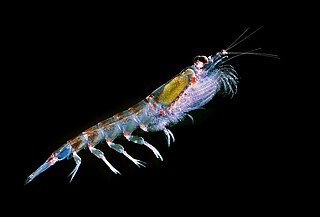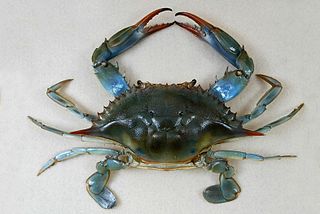Related Research Articles

Krill are small and exclusively marine crustaceans of the order Euphausiacea, found in all the world's oceans. The name "krill" comes from the Norwegian word krill, meaning "small fry of fish", which is also often attributed to species of fish.

Malacostraca is the second largest of the six classes of crustaceans just behind hexapods, containing about 40,000 living species, divided among 16 orders. Its members, the malacostracans, display a great diversity of body forms and include crabs, lobsters, crayfish, shrimp, krill, prawns, woodlice, amphipods, mantis shrimp, tongue-eating lice and many other less familiar animals. They are abundant in all marine environments and have colonised freshwater and terrestrial habitats. They are segmented animals, united by a common body plan comprising 20 body segments, and divided into a head, thorax, and abdomen.

The Decapoda or decapods are an order of crustaceans within the class Malacostraca, including many familiar groups, including crabs, lobsters, crayfish, shrimp, and prawns. Most decapods are scavengers. The order is estimated to contain nearly 15,000 species in around 2,700 genera, with around 3,300 fossil species. Nearly half of these species are crabs, with the shrimp and Anomura including hermit crabs, porcelain crabs, squat lobsters making up the bulk of the remainder. The earliest fossils of the group date to the Devonian.

Johannes Japetus Smith Steenstrup FRS(For) HFRSE was a Danish zoologist, biologist, and professor.
Boas might refer to:

Amphionides reynaudii is a species of caridean shrimp, whose identity and position in the crustacean system remained enigmatic for a long time. It is a small planktonic crustacean found throughout the world's tropical oceans, which until 2015 was considered the sole representative of the order Amphionidacea, due to unusual morphological features. Molecular data however confirm it as a member of the caridean family Pandalidae, and the confusion of morphology is because only larval phases have so far been studied.

Eucarida is a superorder of the Malacostraca, a class of the crustacean subphylum, comprising the decapods, krill, and Angustidontida. They are characterised by having the carapace fused to all thoracic segments, and by the possession of stalked eyes.

Euphausia is the largest genus of krill, and is placed in the family Euphausiidae. There are 31 species known in this genus, including Antarctic krill and ice krill from the Southern Ocean, and North Pacific krill in the Pacific Ocean.

Eumalacostraca is a subclass of crustaceans, containing almost all living malacostracans, or about 40,000 described species. The remaining subclasses are the Phyllocarida and possibly the Hoplocarida. Eumalacostracans have 19 segments. This arrangement is known as the "caridoid facies", a term coined by William Thomas Calman in 1909. The thoracic limbs are jointed and used for swimming or walking. The common ancestor is thought to have had a carapace, and most living species possess one, but it has been lost in some subgroups.

Henrik Schück was a Swedish literary historian, university professor and author.

Johan Erik Vesti Boas, also J.E.V. Boas, was a Danish zoologist and a disciple of Carl Gegenbaur and Steenstrup. During the beginning and end of his career, Johan Erik Vesti Boas worked at the Zoological Museum of Copenhagen. However, during an intervening period of 35 years, Boas worked with the Veterinary and Agricultural University of Copenhagen, because Boas had felt ignored at the appointment of the museum curator post, which went, instead, to G.M.R. Levinsen (q.v.).

Erik Vullum was a Norwegian journalist, writer and politician for the Liberal Party.
Phylogeny of Malacostraca is the evolutionary relationships of the largest of the six classes of crustaceans, containing about 40,000 living species, divided among 16 orders. Its members display a great diversity of body forms. Although the class Malacostraca is united by a number of well-defined and documented features, which were recognised a century ago by William Thomas Calman in 1904, the phylogenetic relationship of the orders which compose this class is unclear due to the vast diversity present in their morphology. Molecular studies have attempted to infer the phylogeny of this clade, resulting in phylogenies which have a limited amount of morphological support. To resolve a well-supported eumalacostracan phylogeny and obtain a robust tree, it will be necessary to look beyond the most commonly utilized sources of data.

The clade Multicrustacea constitutes the largest superclass of crustaceans, containing approximately four-fifths of all described crustacean species, including crabs, lobsters, crayfish, shrimp, krill, prawns, woodlice, barnacles, copepods, amphipods, mantis shrimp and others. The largest branch of multicrustacea is the class Malacostraca.
Elisabeth Deichmann was a Danish-born American marine biologist.

Hedvig Eleonora Parish is a parish in Östermalm's church district (kontrakt) in the Diocese of Stockholm, Sweden. The parish is located in Stockholm Municipality in Stockholm County. The parish forms its own pastorship.

Frederik Riise was a Danish photographer and exhibition curator. He was a noted portrait photographer and is also remembered for his numerous photographs of buildings, streets and monuments in Copenhagen.

A Meeting in the Royal Danish Academy of Sciences and Letters is a monumental 1897 oil-on-canvas group portrait painting by Peder Severin Krøyer, depicting the membership of Royal Danish Academy of Sciences and Letters during one of its meetings in the Prince's Mansion in Copenhagen. The painting was commissioned by the Carlsberg Foundation in conjunction with the construction of its new building on H. C. Andersens Boulevard. Measuring 519.4 cm (204.5 in) wide and 266.7 cm (105.0 in) tall, it is Krøyer's largest painting.
Boreomysinae is a subfamily of large, mostly deep-water oceanic mysid crustaceans from the family Mysidae. The name, which can be translated as "northern mysids", comes from the genus Boreomysis G.O. Sars, 1869, established for Boreomysis arctica from the boreal waters of Atlantic. As more species have been discovered subsequently, the subfamily is considered panoceanic, and includes 38 species from two genera, Boreomysis and Neobirsteiniamysis Hendrickx et Tchindonova, 2020.
References
- ↑ Johan Erik Vesti Boas (1883). "Studien über die Verwandtschaftsbeziehungen der Malacostraken" [Studies on the relationships of the Malacostraca]. Morphologisches Jahrbuch (in German). 8: 485–579.
- ↑ Bernadette Casanova (2003). "Ordre des Euphausiacea Dana, 1852" [The Order Euphausiacea Dana, 1852]. Crustaceana (in French). 76 (9): 1083–1121. doi:10.1163/156854003322753439. JSTOR 20105650.